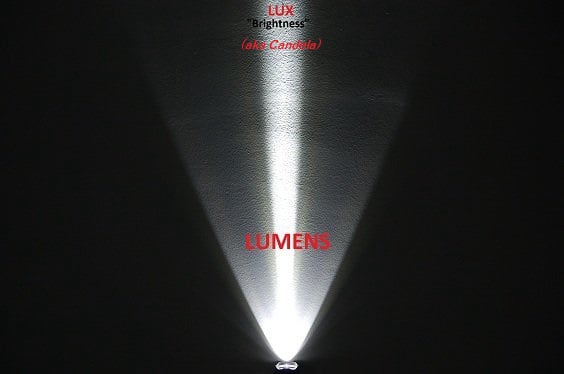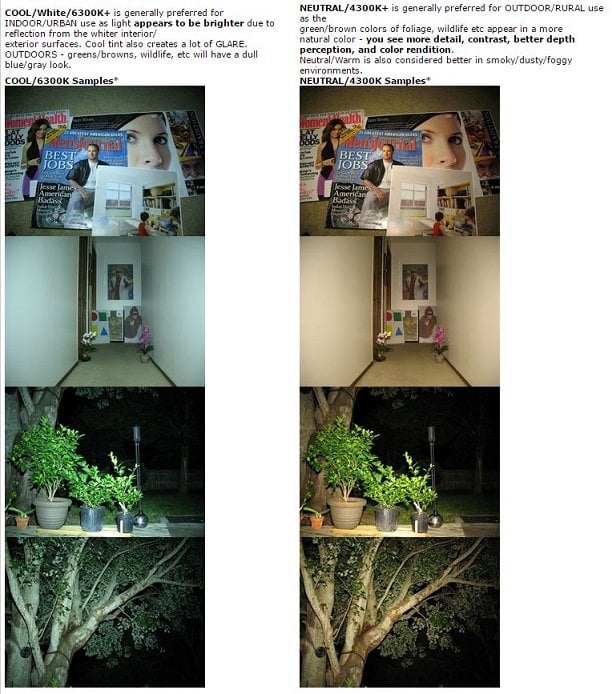FAQ~Frequent Asked Questions received by ETUSA / illuminationGear:
A: LED = Light Emitting Diode, is basically like a tiny light bulb that fits into an electrical circuit, they are super efficient, with high output (now providing 1,000~5,000 Lumens per LED), and with long lasting life expectancy (up to 50,000 hours, and are usually covered under Warranty if there is a failure).
Generally / 99% of time the LED are permanently installed into a light and are not user replaceable (exception are a handful of specific lights that use a specific LED "Module" ~ enter "module" into the search box of our iG site to find these models) NOTE: Different LED also have varying electrical and optical requirements in order to work properly...
A: Very subjective, it all depends on how the light output was measured, how the light output is focused, the Color Temperature, and, how YOUR eyes see it...
but let's first define some common terms:
LUMENS, Bulb Lumens/Emitter Lumens/LED Lumens = amount of light being produced and measured at the surface of the LED.
OTF Lumens = amount of light being produced and measured coming Out~The~Front of light (this accounts for loses with reflector and lens, a 20-30% loss is typical).
ANSI LUMENS = amount of light being produced, and measured OTF of light after a specified amount of time - usually 2-3 minutes. (We compare Lumens and OTF/ANSI Lumens, to the automotive terms of Automotive Crank/Engine Horsepower and Rear wheel/brake Horsepower)
Brightness = LUX, A measure of the intensity of the center spot.
Throw = how far the beam reaches.
TIP: A quick and easy way for any user to more objectively compare one light to another light without sophisticated testing equipment is to perform a "ceiling bounce test".
In a darkened room (bedroom, living room, etc) ~ point flashlight up to center of the ceiling, look down to floor and switch light ON... look at the amount of light reflected down to the floor, wall and surrounding area (not on the ceiling). Do this/compare with another light ~ and you can quickly determine the total amount of light being produced with one light vs another light.
A. With flashlights, the LUX measurement is taken at 1 meter distance, which produces the Candela equivalent
(EX: 25,000 LUX = 25,000 Candela ~ and vice versa).
A. A good observation/baseline provided by our LEO/Military users: "7,500 LUX, allows me to count fingers at 75 meters"!
And note, a 2x LUX does not produce 2x throw!
LUX to throw generally speaking, has a 2 to 1 ratio (2x LUX, provides approx 50% more throw).
Search the internet for "inverse-square law of light", for a full scientific explanation. ;P
Common Misconception: More Lumens makes more throw.
No, not necessarily, it is the focus of output, the size of the reflector/head, and the lumens that creates more throw. (We have several lower lumen lights that easily out throw some of the much higher lumen ones!)
With flashlights ~ Lumens only tells you how much light is being produced, not how it is focused, by adding LUX to the equation one can determine what type of output should be expected when compared to another light... EX: more floody vs more throwy etc.
NOTE: WE do not use "Beam Distance" ("the distance in meters at which a flashlight produces a light intensity of 0.25 LUX") as a spec for any of our products, as .25 LUX measurement is meaningless in the real world, and, would also depend on what you were wanting to light up.
EX: Seeing a brown barn at 300 meters is far more impressive than seeing a white barn at 300 meters.
Lumens + LUX are the best easily verifiable and objective specs to compare lights:
Want more light output, look at Lumens ~
want more distance/throw, look at LUX.
More Info http://flashlightwiki.com/Main_Page
A. Watts is generally referring to power/energy consumed, not the actual light output.
Watts is used with household/commercial bulbs etc to tell you how much they will cost to operate over x period of time ~ with today's high efficiency LED and circuitry, wattage is not used as it doesn't tell you how much light is being produced, only how efficient or inefficient the LED driver circuitry is. ;P
EX: In the household, a 100w light bulb, vs 100w flood light, vs 100w spot light all create 100 watts of light (approx 1,600 Lumens),
ie. they produce the same 100w/1,600 lumens ~ but the output beam appearance and use is going to be completely dependent on how the light output is focused (an area light, vs a flood light, vs a spot light).
(FYI, typical relatable conversion is: a 40w bulb produces approx 450 lumens, 60w bulb produces approx 800 lumens, 75w bulb approx 1,100 lumens, 100w bulb approx 1,600 lumens, etc ~ and vice versa)
A: Each LED has specific pro/cons compared to others, so just depends on your intended use, this answer also changes year to year/sometimes month to month due to constantly evolving LED technology:
2022+ ~ Luminus SFT40 highest lumen output lower voltage/small format LED, replacing the Cree XM-L2 and many others, with added advantage of the higher LUX of the XP-L HI (but, is only available in Cool White output).
2019/2020 ~ The Osram CSLPM1 offers the highest luminance (cd/mm2) for it's size and a low voltage requirement, producing a narrow beam and long range ~ ideal in smaller lights that have a lower voltage and a smaller reflector (but, CSLPM1 is only available in cool white).
And, we are adding the Luminus SST-20 4000K R9 CRI 95+ LED which offers similar Lumens/LUX compared to the Nichia 219, and it has higher CRI with addition of the R9 value (vibrant red).
2017+ CREE XHP35/50/70 HD & HI LED series is quickly replacing the XM-L2/XP-L HI LED in many lights, and Lumens are approx. 2,000/3,000/5,000 per LED, with HD or HI options. The XHP HD LED beam is similar to XM-L2 (general purpose), and XHP HI LED beam is similar to XP-L HI Domeless beam (focused/tighter for maximum reach), the catch is that these high voltage LED, require high amperage power to run them. Thus battery/power source will determine which light model these high power LED can be used in, and, user must use high quality name brand batteries that are rated above 8amps.
2015~2017 The common/popular choice is the CREE XM-L2 (which replaced the XM-L) ~ depending on light it is installed into, it provides up to approx 1,400 lumens +/- per LED, and offers best "general purpose beam" characteristics.
The next popular choice is the CREE XP-L HI Domeless LED (which is now used instead of the old XP-G/XP-G2), and gives slightly less Lumens than the XM-L2, but beam output is more focused/tighter/brighter, thus is best for those wanting maximum reach/high LUX output.
We also have several custom built lights using specialized high output LED's ~ such as Red, Green, Blue, Amber, Cyan, InfraRed/IR, UltraViolet/UV, etc output (which far exceeds the output from a white light with a special filter applied in front of it).
A: Traditional everyday common LED have a clear epoxy "Dome" lens/optic over the die/semiconductor for gathering up and focusing the light output.
A "HI" designation is High Intensity (vs traditional Domed HD / High Density) a "domeless" LED is manufactured with a flat lens rather than a domed lens.
(a "de-domed" LED means someone has removed the dome via cutting/grinding etc after the LED was manufactured.)
HI / Domeless LED produce tighter/more focused light output = higher LUX, at a small penalty of loss of lumens/efficiency. https://en.wikipedia.org/wiki/Light_extraction_in_LEDs
EX: CREE XP-L HD, http://www.cree.com/led-components/products/xlamp-leds-discrete/xlamp-xp-l
vs
CREE XP-L HI, aka High Intensity, aka Domeless
http://www.cree.com/led-components/products/xlamp-leds-discrete/xlamp-xp-l-high-intensity

